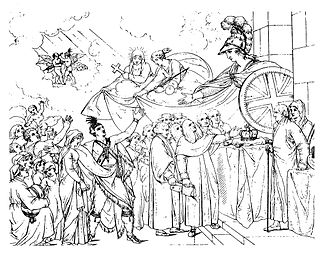
Back موالي (الثورة الأمريكية) Arabic Loyalistlər (Amerika inqilabı) Azerbaijani Лаялісты Byelorussian Лоялист (Американска революция) Bulgarian Loyalist Catalan Loyalisté (Americká revoluce) Czech Loyalist (amerikanske revolution) Danish Loyalisten German Lealista (guerra de Independencia de Estados Unidos) Spanish وفادارماندگان Persian


Loyalists were colonists in the Thirteen Colonies who remained loyal to the British Crown during the American Revolutionary War, often referred to as Tories,[1][2] Royalists or King's Men at the time. They were opposed by the Patriots, who supported the revolution, and called them "persons inimical to the liberties of America."[3]
Prominent Loyalists repeatedly assured the British government that many thousands of them would spring to arms and fight for the Crown. The British government acted in expectation of that, especially during the Southern campaigns of 1780 and 1781. Britain was able to effectively protect the people only in areas where they had military control, and in return, the number of military Loyalists was significantly lower than what had been expected. Due to conflicting political views, loyalists were often under suspicion of those in the British military, who did not know whom they could fully trust in such a conflicted situation; they were often looked down upon.[4]
Patriots watched suspected Loyalists very closely and would not tolerate any organized Loyalist opposition. Many outspoken or militarily active Loyalists were forced to flee, especially to their stronghold of New York City. William Franklin, the royal governor of New Jersey and son of Patriot leader Benjamin Franklin, became the leader of the Loyalists after his release from a Patriot prison in 1778. He worked to build Loyalist military units to fight in the war. Woodrow Wilson wrote that
"there had been no less than twenty-five thousand loyalists enlisted in the British service during the five years of the fighting. At one time (1779) they had actually outnumbered the whole of the continental muster under the personal command of Washington."[5]
When their cause was defeated, about 15 percent of the Loyalists (65,000–70,000 people) fled to other parts of the British Empire; especially to Britain itself, or to British North America (now Canada).[6] The southern Loyalists moved mostly to Florida, which had remained loyal to the Crown, and to British Caribbean possessions. Northern Loyalists largely migrated to Ontario, Quebec, New Brunswick, and Nova Scotia. They called themselves United Empire Loyalists. Most were compensated with Canadian land or British cash distributed through formal claims procedures. Loyalists who left the US received over £3 million or about 37% of their losses from the British government. Loyalists who stayed in the US were generally able to retain their property and become American citizens.[7] Many Loyalists eventually returned to the US after the war and discriminatory laws had been repealed.[8] Historians have estimated that between 15% and 20% (300,000 to 400,000) of the 2,000,000 whites in the colonies in 1775 were Loyalists.[9]
- ^ Chopra, Ruma (7 June 2013). Choosing Sides: Loyalists in Revolutionary America. Rowman & Littlefield Publishers. p. 30. ISBN 978-1-4422-0573-4.
- ^ Hoock, Holger (9 May 2017). Scars of Independence: America's Violent Birth. Crown. p. 29. ISBN 978-0-8041-3729-4.
- ^ Barbara Smith (2013). The Freedoms We Lost: Consent and Resistance in Revolutionary America. New Press. p. 142. ISBN 978-1595585974.
- ^ Devoss, David (January 2004). "Divided Loyalties". Smithsonian. Archived from the original on June 23, 2016. Retrieved July 11, 2019.
Curiously, Tories suffered even at the hands of British officers who, for the most part, dismissed them as ignorant provincials. The British especially distrusted Loyalist militia regiments, claiming that they were slow to follow orders and often went off on their own to seek revenge against those who had destroyed their property.
- ^ Woodrow Wilson. The Coming of Peace, Harper's New Monthly Magazine, Volume 104, December 1901, p. 110.
- ^ G. Patrick O'Brien. Refugees after the American Revolution needed money, homes and acceptance Archived 2022-04-10 at the Wayback Machine, The Conversation, August 31, 2021
- ^ Calhoon, Robert M. (2008). "Loyalism and Neutrality". In Greene, Jack P.; Pole, J. R. (eds.). A Companion to the American Revolution. John Wiley & Sons. pp. 246, 399, 641–642. ISBN 978-0-470-75644-7.
- ^ "Loyalist | Definition & Facts". www.britannica.com. Archived from the original on 2022-09-20. Retrieved 2022-09-18.
- ^ Calhoon, "Loyalism and neutrality", p. 235; Middlekauff (2005) pp. 563–564; Thomas B. Allen, Tories: Fighting for the King in America's First Civil War (2010) p. xx